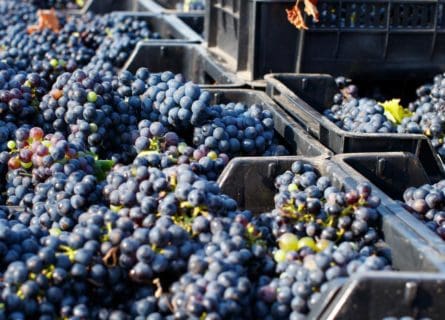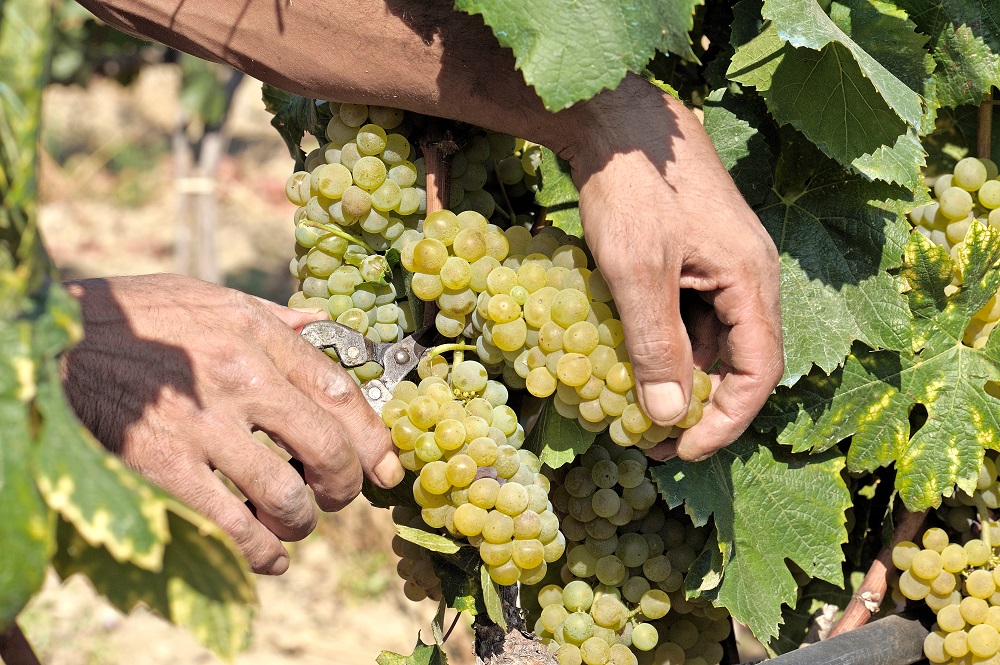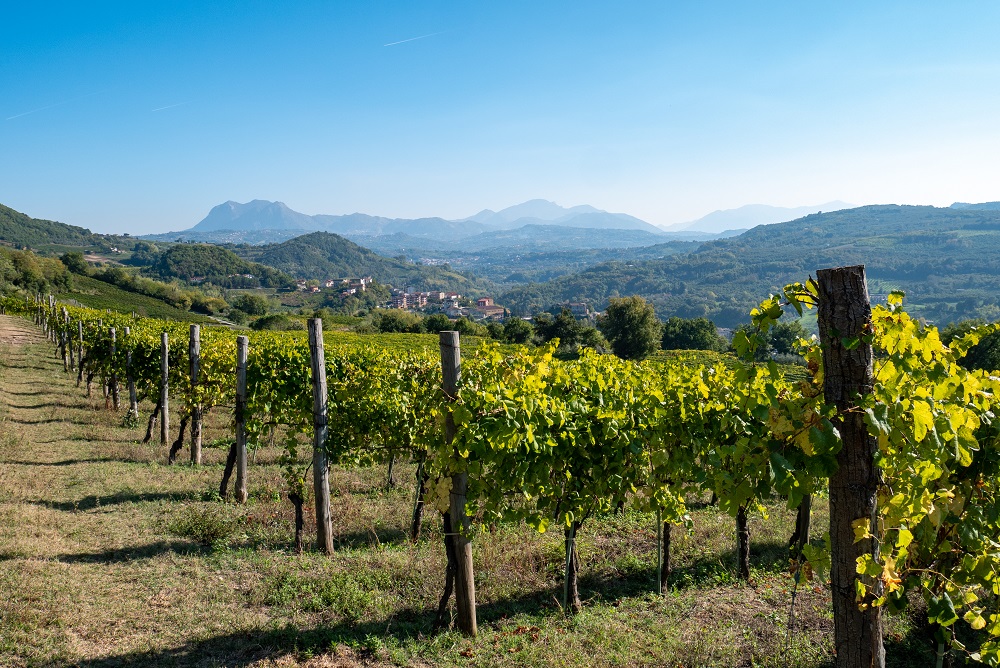
Negroamaro Grape Variety: The Secret Ingredient in the Best Red Wines of Puglia
October 15, 2021
Discover Negroamaro: Italy's Hidden Gem from Puglia's Vinous Revival. Explore its robust character and rising star status in winemaking.
Estimated reading time: 8 minutes
Is there a region as dynamic and exciting as Campania? Or less easy to pigeonhole? Described as Oenotria (land of wine) by the colonizing Greeks, the majestic terrain of southern Italy holds many secrets. Who would have imagined, for example, that these warm volcanic soils could yield such incredibly fresh and racy white wines? But they do – some of Italy’s most exciting creations are now made in Campania, ranging from the decadent opulence of Aglianico to the beguiling complexity of Fiano.

Guide to Italian White Wine: Read more
Of course, every region needs a flagship grape or emblem. In Campania, rising profit margins easily demonstrate which variety has captured the imagination of sommeliers and consumers across the globe. It is called Greco. It cannot produce lackluster wine unless the grower chases an inflated crop. But under most circumstances, Greco will refresh your palate with its crisp, mineral-scented, and racy fruit. Today it remains a leading contender for Italy’s finest white grape. And, unlike some other styles, the disappointments are few and far between.
Campanian wines have vivacity, originality, and almost indescribable potency. But the region’s talented winemakers cannot take all the credit: Campania’s topography and soils are very diverse, including high-elevation slopes and mineral-rich volcanic terroir. This provides endless opportunities to fashion unique and delicious wines. Indeed, historians suspect that it is the region’s fertile land and benign climate that first attracted Etruscan settlers, followed by the Greeks and Romans. The Greeks, however, played the most prominent role in laying the foundations for a thriving wine industry; viticulturists believe that Greek settlers introduced an ancestor of Greco in the 8th century BC. Or, to be more precise, it was supposedly imported by the Pelasgians, an ethnic group that originated in Thessaly in Greece.
Moreover, although there is no definitive evidence, winemakers have often suggested that Greco – or its ancestor – was a key component in the Roman wine Falernian. The Roman poet Pliny the Elder described This unctuous brew most enthusiastically. Based on Greco and, quite possibly, Falanghina, the wine was boiled, sweetened, and adulterated with herbs. Contemporary wine lovers would be horrified – the Roman elite drank glass after glass with wild abandon.
In 476 AD, the Western Roman Empire came apart at the seams. This created a political chasm in southern Italy, paving the way for invasions and violent territorial conflicts. Eventually, the Normans (conquerors of England in 1066) managed to subjugate the wider region, founding the Kingdom of Sicily as a united political entity. Nevertheless, maintaining order proved more difficult than anticipated; a series of rebellions broke out in the 13th century, forcing the Normans to abandon their claim to the Mediterranean’s largest island. However, no such independence was achieved in Campania – the province became absorbed into the Kingdom of Aragon and eventually the Spanish Empire. Nevertheless, this was a time of relative peace and economic prosperity for the region’s agrarian community, not least due to the commercial benefits of trading within the empire. However, it was not until the 1860s that Campania was officially absorbed into a unified Italian state.
Unfortunately, the violence and economic devastation of the Second World War negatively impacted wine growing across southern Italy. Many vineyards had been destroyed by shelling and bomb attacks; large swathes of farmers emigrated to the cities in the 1950s as viticulture had become financially nonviable. This led to producers grubbing up the remaining vines, often selling land for property development.
Then Italy entered its ‘international phase.’ A post-war boom in the 1960s created a national wine market; however, investors decided to bet on the global popularity of international grapes like Sauvignon Blanc and Merlot. As a result, a great deal was planted in the 1970s and 80s, while indigenous varieties such as Greco came dangerously close to extinction. Nevertheless, Campanian’s wine industry would have never recovered if not for visionaries like Antonio Mastroberardino and Feudi di San Gregorio. These pioneers saw the wisdom in focusing on local grapes and Italian flavors – this approach has paid dividends in the 21st century. Indeed, Greco has benefited enormously from the shift toward authenticity and wines that show a sense of place. After an inauspicious beginning, Greco has been transformed into one of Italy’s most popular white styles.
So is it easy to grow? First, the answer needs to be clarified: Greco can produce a decent (but not excessive) yield of ripe grapes in good vintages. Moreover, berries maintain good acidity levels, even during hotter years. Yet the grape’s thin skins are notoriously susceptible to fungal diseases such as downy and powdery mildew. Fortunately, inclement weather is relatively uncommon in the hills of southern Italy.
Greco is a grape defined by its origins: that salinity and racy minerality you’ve heard so much about is highly seductive. But, these valuable characteristics are a product of volcanic terroir rather than human manipulation. Therefore, winemakers practice a very ‘hands-off’ approach when vinifying Greco, rarely exposing the grape to oak fermentation and/or maturation.
Feudi di San Gregorio provides us with a standard template. In essence, the same philosophy underpins winemaking in Alsace: the juice is protected at all times to preserve its aromatic profile. First, whole bunches are chilled and then gently pressed in a pneumatic machine – technology has evolved toward achieving a very high level of precision when releasing must from berries. This crystal-clear, free-run juice is then chilled into settling vats. After the solid matter – skins and pulp – has settled at the bottom of the tank, the must is transferred to the fermentation vessel of choice.
This, inevitably, will be stainless steel. Visitors to wineries often ask why producers are so committed to this ubiquitous sight – is it laziness? A lack of alternatives? The answer is a resounding no: stainless steel is easy to clean and very effective at making fruit-driven, aromatic styles of white wine. This is because it allows the temperature to be precisely controlled at all times, protecting the fruity esters and other compounds from ‘burnout.’ After fermentation, Feudi di San Gregorio prefers to age its wines on the fine lees for several months, adding flavor and zip to the wine (this yeasty sediment is a powerful antioxidant). After that, malolactic fermentation may occur if the acidity is sufficiently high enough to warrant it.
Of course, only some winemakers demand clean fruit and crystalline purity. Brimming with passion and a thirst for experimentation, winemaker Roberto Bruno has been pushing the envelope with Greco. His pretty estate, Petillia, produced a small volume of skin-contact wine in 2019 – no sulfites are used, and the wine is bottled unfiltered. Yet it is fresh as a daisy, regardless of the wine’s deep orange hue and exotic bouquet of honeysuckle and lanolin. Nevertheless, we suspect that most consumers prefer their Greco wines lightly and saline. But the choice of styles is appreciated, all the same.

The beautiful vineyards of Greco di Tufo
The tide has turned in Italy. Once, the nation was in danger of surrendering to bland imports and ubiquitous grape varieties; the lure of a quick buck is always difficult to resist. Yet a dramatic cultural shift forced the Italians to look inwards rather than outwards, returning to a paradigm that cherishes traditional grapes and styles. In Campania, you now have to search hard to find a replica of Loire Sauvignon Blanc or Chilean Merlot. That can only be a good thing for oenophiles who crave a point of difference.
Greco, the much-loved white grape of Irpinia, has played an important role in this evolving story. With investment and interest booming—the total vineyard acreage increases yearly—there is much to celebrate. Moreover, a drab or uninteresting glass of Greco is rare. Instead, it’s almost guaranteed to knock your socks off; few can resist the grape’s opulent bouquet and spicy acidity.
However, there are always hierarchies in the world of wine. You must explore the vineyards northeast of Naples to seek the crème de la crème of Greco wines. In the province of Irpinia, you’ll discover the small appellation of Greco di Tufo, situated to the immediate north of Fiano di Avellino. Awarded DOCG status in 2003, its close-knit community of growers continues to make some of Campania’s best whites: substantial wines with an apple-peel fragrance and mineral depths – they are irresistible when paired with local seafood.
Over the years, Greco di Tufo has grown from a tiny, unremarkable wine zone into a beacon of premium quality. The secret of the appellation’s success is twofold. First, the natural conditions are very favorable: vines are planted on mineral-rich tufo soils, formed after Vesuvius erupted, spewing ash and lava across Campania. Tufo – tuff in English – is compacted and ‘terraformed’ volcanic matter. In addition, the best sites are found at an altitude of 450 to 500 meters above sea level. This encourages a slower rate of ripening – retaining vital acidity – due to the strong diurnal temperature variation. This polarity between day and night temperatures makes all the difference in the balmy Mediterranean climate of southern Italy.
Second, the area is blessed with talented winemakers, such as Roberto Bruno, who deeply understand their terroir. Because of their passion for local grapes, the 20th-century reverence for international varieties is fading fast. Today, Campanian vines and wines are, rightfully, once more being celebrated for being Campanian. The future looks bright.
If you would like us to customize an exclusive luxury tour, contact us and let us know your travel plans. We offer luxury food and wine tours for private groups of a mininium two guests. In addition, all of our private, chauffeured tours are available year-round upon request.

